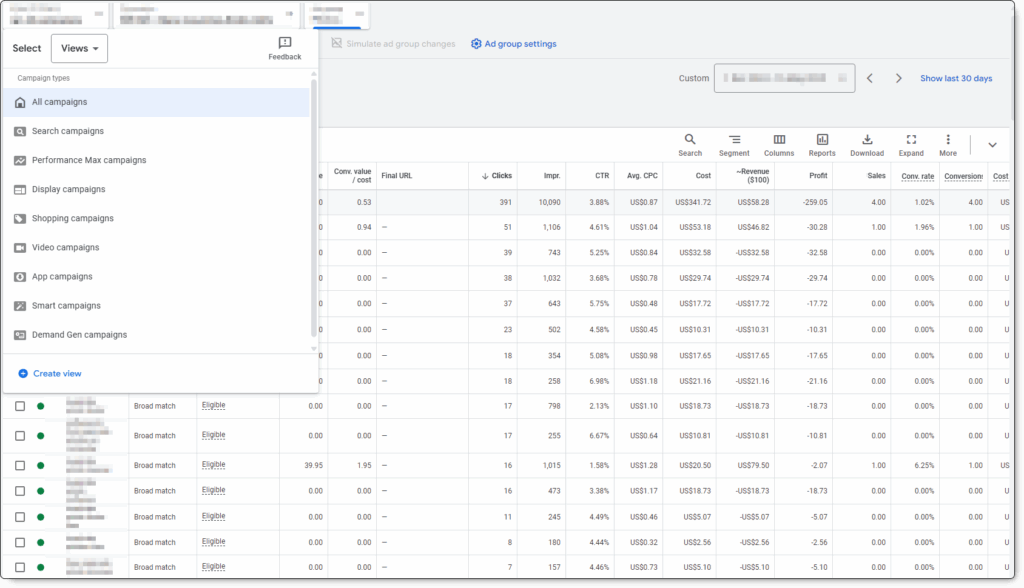Every time I go into a Google Ads account, I understand less about what I see.
And that’s despite more than twenty-five years in digital marketing.
This complexity led me to a slightly disturbing thought.
That Google Ads has become both essential and dangerous for small businesses.
Essential because it’s still one of the fastest routes to new customers.
Dangerous because its complexity makes it easy to waste money.
More of that later.
In this article, I’ll explore six counterintuitive reasons why small businesses should consider Google Ads, while being brutally honest about the risks of each approach.
If it looks overwhelmingly complicated to me, imagine how it feels to a typical small business owner, who just wants to grow their company.
The Digital Rent Concept
Consider Google Ads not as advertising, but as rent for premium digital real estate.
Like a physical store on a busy street, paying more for rent for higher visibility.
When you stop paying rent, you immediately lose visibility and visitors.
Digital visibility requires ongoing investment.
Propaganda check: This is a solid idea that underpins Google Ads.
But we’ve seen countless accounts where companies are bidding on terms they already rank highly for.
For brand terms, this makes sense, but used carelessly, a business could pay for searches it would have received for free.
Remember there are many settings and options within a Google Ads account.
Most of which default to being in Google’s favour.
As with most things Google Ads, caution, skill and monitoring are advised.
Unlike some business rent options, there’s no price lock-in. Advertising expenses always rise.
This leaves you at the mercy of your effective landlord. When they raise the prices suddenly and dramatically, you won’t be able to do anything.
The best way to at least limit the extent of the raises would be to strengthen your account management skills.
The Discovery Gap Paradox
This premium placement you’re paying for enables something even more powerful than mere visibility.
Many small businesses offer solutions to problems people don’t realise they have.
This creates the discovery gap – where people search for workarounds or partial solutions, simply because they don’t know better options exist.
Google Ads can solve this problem by positioning these solutions in front of the people seeking them.
In other words, your ads can effectively intercept the searches with better solutions.
This gives the small business powers far beyond their conventional spending capabilities.
A person searching for an energy-efficient heater could see an ad for a room insulation kit.
A business seeking a document-sharing cloud infrastructure might consider a Synology Network Storage Device.
Propaganda check: This idea is credible, but relies on one of two scenarios.
First, that the account is set up correctly to target these.
Having seen hundreds of Google Ads accounts, I can tell you that most accounts waste ad spend and opportunities.
The second is that you trust Google to know where and when to display your ads.
Google is heavily pushing a “trust us, we know what you want” agenda.
But the trust-the-black-box idea doesn’t sit well with me.
Mainly because the black box is Google’s mechanism for making money from their advertisers. You.
Outset of Journey Intervention
Understanding how to bridge the discovery gap often reveals a crucial timing question.
Recent research shows that about 98% of consumers research online before buying.
The standard model is a basic funnel: from awareness to broad research to consideration to shortlist to decision.
If your solution doesn’t appear in the initial research stage, you’ve missed your opportunity.
Google Ads allows you to be visible at that one-time research moment.
Propaganda check: With today’s high ad costs, there’s a very slim chance of your ad being displayed every time your solution is searched.
Ensuring constant visibility in searches isn’t as simple as you might expect. Unless your niche is incredibly specific, costs can be high.
In Google Ads, there’s no way to differentiate between a casual search and someone making a shortlist.
Expertise Perception
While being visible early in the customer journey is critical, how you appear matters just as much as when you appear.
This brings us to a powerful psychological advantage of consistent advertising.
The “mere exposure effect” is a fantastic psychological principle.
The more we see something, the more we trust it.
It’s why big brands repeatedly show you the same ads, even when the context and timing seem strange.
They’re not trying to get you to buy right now – they’re building familiarity and trust.
When choosing between two similar products, you’ll often lean towards the one you’ve heard of, even if you can’t explain why.
Stripping aside the fluff – the more potential customers see your product, the more likely they are to remember and trust you.
You’re not just paying for clicks, but also for cumulative exposure.
Propaganda check: While the idea is solid, the customer must see your ad and associate it with your product or brand.
I searched for email overload and saw this ad:
Yes, you can see the website’s domain, but most people won’t notice that.
They’ll only notice this:
Since the product name isn’t mentioned in the ad text, there’s nothing to trigger that effect.
Low Risk Testing
All of these visibility benefits lead us to perhaps the most useful application for small businesses.
At some point, you may have had an excellent idea – a new product or service that you were sure would be a hit.
You developed the product, wrote the content, prepared the website and worked on supporting publicity posts.
When you launched it, you probably didn’t expect overwhelming sales.
But you hoped for some interest.
Instead – nothing. Silence.
Familiar?
If you’d launched a tentative Google Ads campaign, you could’ve spared yourself a lot of work and wasted time.
With just a basic landing page, you can measure the response with a modest budget.
From there, you could decide to refine, adapt or abandon the idea.
Even in the worst-case scenario, the time investment would be minimal.
Propaganda check: This is a pretty robust use of Google Ads, with some cautions.
If the landing page offer is weak, like a “register your interest here”, most visitors will leave.
Even if they’re interested in your product, you might find it impossible to gauge their interest.
Setting up the entire test would require extreme care.
The ads, bidding, campaign, landing page, offer and conversion measurement. Inaccurate data could be costly.
Survival of the fittest
Beyond testing and visibility, there’s a strategic reason to maintain a Google Ads presence.
This is obvious, but it needs mentioning.
You’ll probably at some point have been affected by a Google algorithm update.
For small businesses, this can be devastating.
With over 25 years in SEO, I know the warning signs.
There aren’t any.
You can have a normal, rule-abiding website, having done nothing wrong.
One morning, you wake up to find 40-50% of your organic traffic gone.
If you think this sounds far-fetched, the countless requests for assistance I’ve handled prove it’s very much real.
Google Ads provides immunity to the algorithm.
A consistent presence, unaffected by the chaotic organic world.
Investing a modest budget in Google Ads provides a safety net, and the budget can be adjusted quickly if required.
Propaganda check: Every aspect of this principle holds true.
The only real weakness is that, unlike an insurance policy, setting up your safety net can be complex and costly.
Get it wrong, and you’ll waste money and be inadequately protected if the algorithm hits the fan.
Conclusion
There’s an uncomfortable truth about Google Ads.
One that needs addressing.
It’s simultaneously one of the most powerful marketing tools for small businesses and one of the most dangerous to use without expertise.
The six reasons I’ve outlined aren’t just benefits – they’re opportunities.
But each can grow your business or drain your budget, depending on execution.
What’s frustrating is Google’s constant pushing for automation and black-box solutions, essentially saying “trust us, we know what’s best for your business.”
Remember who’s making money from every click.
I started working with Google Ads before it was public.
I have no faith in Google’s honesty or trustworthiness.
Their defaults, their claims or their intentions.
Here’s my conclusion: Google Ads is very much worth considering, but approach it with equal enthusiasm and caution.
The initial learning curve is steep. This isn’t something that you can learn just by skimming a couple of articles.
Once the account is active, even with automation, you should realistically expect to spend at least two or three hours per week.
Monitoring performance, adjusting bids, analysing results and expanding on what works.
It’s as far removed from set-it-and-forget-it as you can get.
Trying to just “get it running ASAP” means you risk joining the majority of small businesses who effectively donate money to Google through poorly managed campaigns.
Remember that Google Ads is a tool, not a solution. Like any powerful tool, it requires caution and expertise to use effectively.
Unique ideas for your business
The Demystifier puts practical ideas into your hands. You won't find them elsewhere. Original, actionable and insanely effective.






